The DirectX 12 Performance Preview: AMD, NVIDIA, & Star Swarm
by Ryan Smith on February 6, 2015 2:00 PM EST- Posted in
- GPUs
- AMD
- Microsoft
- NVIDIA
- DirectX 12
CPU Scaling
Diving into our look at DirectX 12, let’s start with what is going to be the most critical component for a benchmark like Star Swarm, the CPU scaling.
Because Star Swarm is designed to exploit the threading inefficiencies of DirectX 11, the biggest gains from switching to DirectX 12 on Star Swarm come from removing the CPU bottleneck. Under DirectX 11 the bulk of Star Swarm’s batch submission work happens under a single thread, and as a result the benchmark is effectively bottlenecked by single-threaded performance, unable to scale out with multiple CPU cores. This is one of the issues DirectX 12 sets out to resolve, with the low-level API allowing Oxide to more directly control how work is submitted, and as such better balance it over multiple CPU cores.
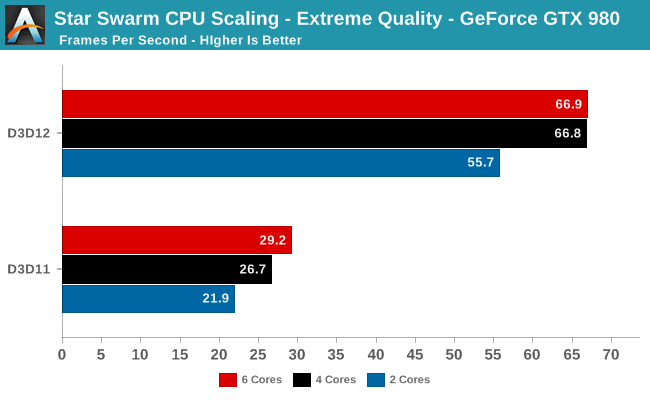
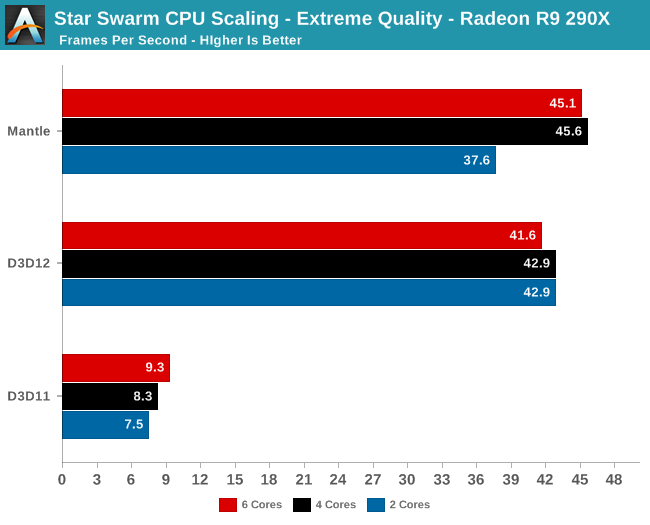
Starting with a look at CPU scaling on our fastest cards, what we find is that besides the absurd performance difference between DirectX 11 and DirectX 12, performance scales roughly as we’d expect among our CPU configurations. Star Swarm's DirectX 11 path, being single-threaded bound, scales very slightly with clockspeed and core count increases. The DirectX 12 path on the other hand scales up moderately well from 2 to 4 cores, but doesn’t scale up beyond that. This is due to the fact that at these settings, even pushing over 100K draw calls, both GPUs are solidly GPU limited. Anything more than 4 cores goes to waste as we’re no longer CPU-bound. Which means that we don’t even need a highly threaded processor to take advantage of DirectX 12’s strengths in this scenario, as even a 4 core processor provides plenty of kick.
Meanwhile this setup also highlights the fact that under DirectX 11, there is a massive difference in performance between AMD and NVIDIA. In both cases we are completely CPU bound, with AMD’s drivers only able to deliver 1/3rd the performance of NVIDIA’s. Given that this is the original Mantle benchmark I’m not sure we should read into the DirectX 11 situation too much since AMD has little incentive to optimize for this game, but there is clearly a massive difference in CPU efficiency under DirectX 11 in this case.
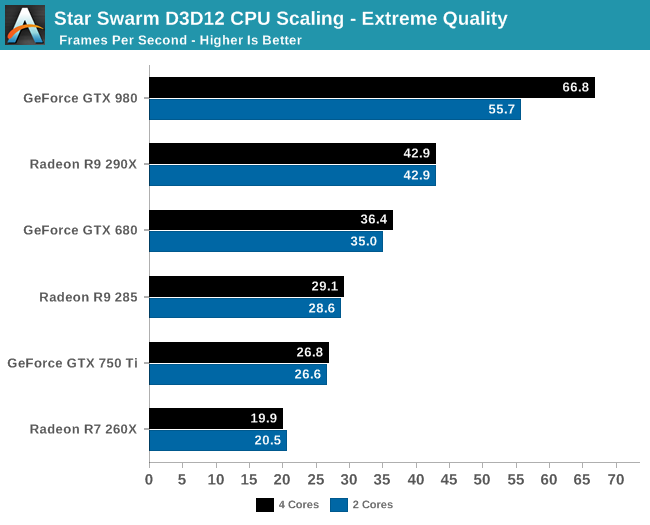
Having effectively ruled out the need for 6 core CPUs for Star Swarm, let’s take a look at a breakdown across all of our cards for performance with 2 and 4 cores. What we find is that Star Swarm and DirectX 12 are so efficient that only our most powerful card, the GTX 980, finds itself CPU-bound with just 2 cores. For the AMD cards and other NVIDIA cards we can get GPU bound with the equivalent of an Intel Core i3 processor, showcasing just how effective DirectX 12’s improved batch submission process can be. In fact it’s so efficient that Oxide is running both batch submission and a complete AI simulation over just 2 cores.
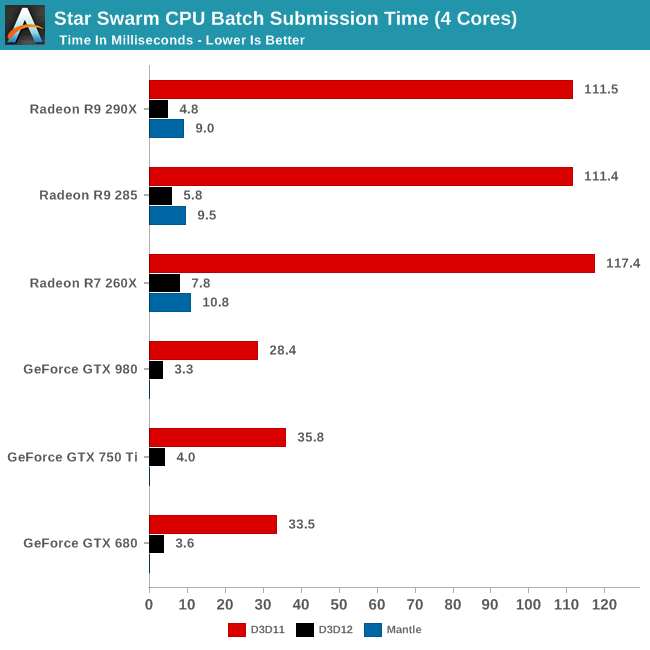
Speaking of batch submission, if we look at Star Swarm’s statistics we can find out just what’s going on with batch submission. The results are nothing short of incredible, particularly in the case of AMD. Batch submission time is down from dozens of milliseconds or more to just 3-5ms for our fastest cards, an improvement just overof a whole order of magnitude. For all practical purposes the need to spend CPU time to submit batches has been eliminated entirely, with upwards of 120K draw calls being submitted in a handful of milliseconds. It is this optimization that is at the core of Star Swarm’s DirectX 12 performance improvements, and going forward it could potentially benefit many other games as well.
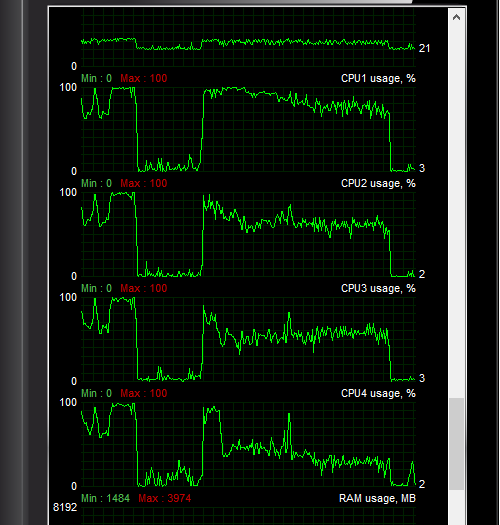
Another metric we can look at is actual CPU usage as reported by the OS, as shown above. In this case CPU usage more or less perfectly matches our earlier expectations: with DirectX 11 both the GTX 980 and R9 290X show very uneven usage with 1-2 cores doing the bulk of the work, whereas with DirectX 12 CPU usage is spread out evenly over all 4 CPU cores.
At the risk of speaking to the point that it’s redundant, what we’re seeing here is exactly why Mantle, DirectX 12, OpenGL Next, and other low-level APIs have been created. With single-threaded performance struggling to increase while GPUs continue to improve by leaps and bounds with each generation, something must be done to allow games to better spread out their rendering & submission workloads over multiple cores. The solution to that problem is to eliminate the abstraction and let the developers do it themselves through APIs like DirectX 12.










245 Comments
View All Comments
dakishimesan - Friday, February 6, 2015 - link
Because DirectX 10 and WDDM 2.0 are tied at the hip, and by extension tied to Windows 10, DirectX 12 will only be available under Windows 10.dakishimesan - Friday, February 6, 2015 - link
PS: great article.FlushedBubblyJock - Sunday, February 15, 2015 - link
First thoughts: R9 290X dx11=8 frames mantle=46 frames TEST= TOTAL FRAUDAlthough the difference there is what AMD told us mantle would do, only in this gigantic liefest is such hilarity achieved.
Another big industry lie-test blubbered out to the sheep at large.
0ldman79 - Monday, February 16, 2015 - link
It looks more like the people that coded that game are not very experienced and have spent far more time optimizing for future API than DX11.Christopher1 - Monday, February 16, 2015 - link
Not necessarily. DX11 no matter how 'optimized' still does not get you as close 'to the metal' as Mantle does. So yes, there can be these kinds of extreme differences in FPS.The_Countess666 - Thursday, February 19, 2015 - link
they are in fact very experienced. but they choose to do the things that previously DX11 bottleneck prevented them from doing in the past.0ldman79 - Saturday, February 21, 2015 - link
That makes sense, still not quite an apples to apples comparison in that situation, though using previously unavailable features on the new API tends to show the differences.The question still remains, will we see similar improvements on the current crop of DX11 games?
I don't think that will be the case, though I could be wrong.
Seems the gains are from multithreading, which is part of the DX11 or 11.1 spec.
RobATiOyP - Sunday, February 21, 2016 - link
Of course you won't see such a performance increase, because games have to be designed and tuned to what the platform is capable of. The console API's have allowed games, lower level access, Mantle, DX12 & Vulkan are about removing a bottleneck caused by the assumptions in DX11 & OpenGL API's which were designed when GPUs were novel items and much evolution has occured since. Those doubting the benchmark, please say why a graphics application would not want to do more draw calls per second!Fishymachine - Monday, February 16, 2015 - link
DX11 can manage up 10k draw calls, Star Storms makes 100k. Also Assasins Creed Unity makes up to 50k in case you wanted a retail game that would skyrocket in low API(there's a spot where even 2 GTX980 get 17fps)The_Countess666 - Thursday, February 19, 2015 - link
this engine was spefiically written to do all the things that previously DX11 doesn't allow game developers to do. it was designed to run headlong into every bottleneck that DX11 has.it is in fact a great demonstrations of the weaknesses of DX11.
the fact that nvidia gets higher framerates in dx11 then ATI is because they optimized the hell out of this game. that isn't viable (costs too much, far too time consuming) for every game and was purely done by nvidia for marketing, but all it really does is further illustrate the need for a low level API where the burden of optimizations is shifted to the game engine developers where it belongs, not the driver developers.